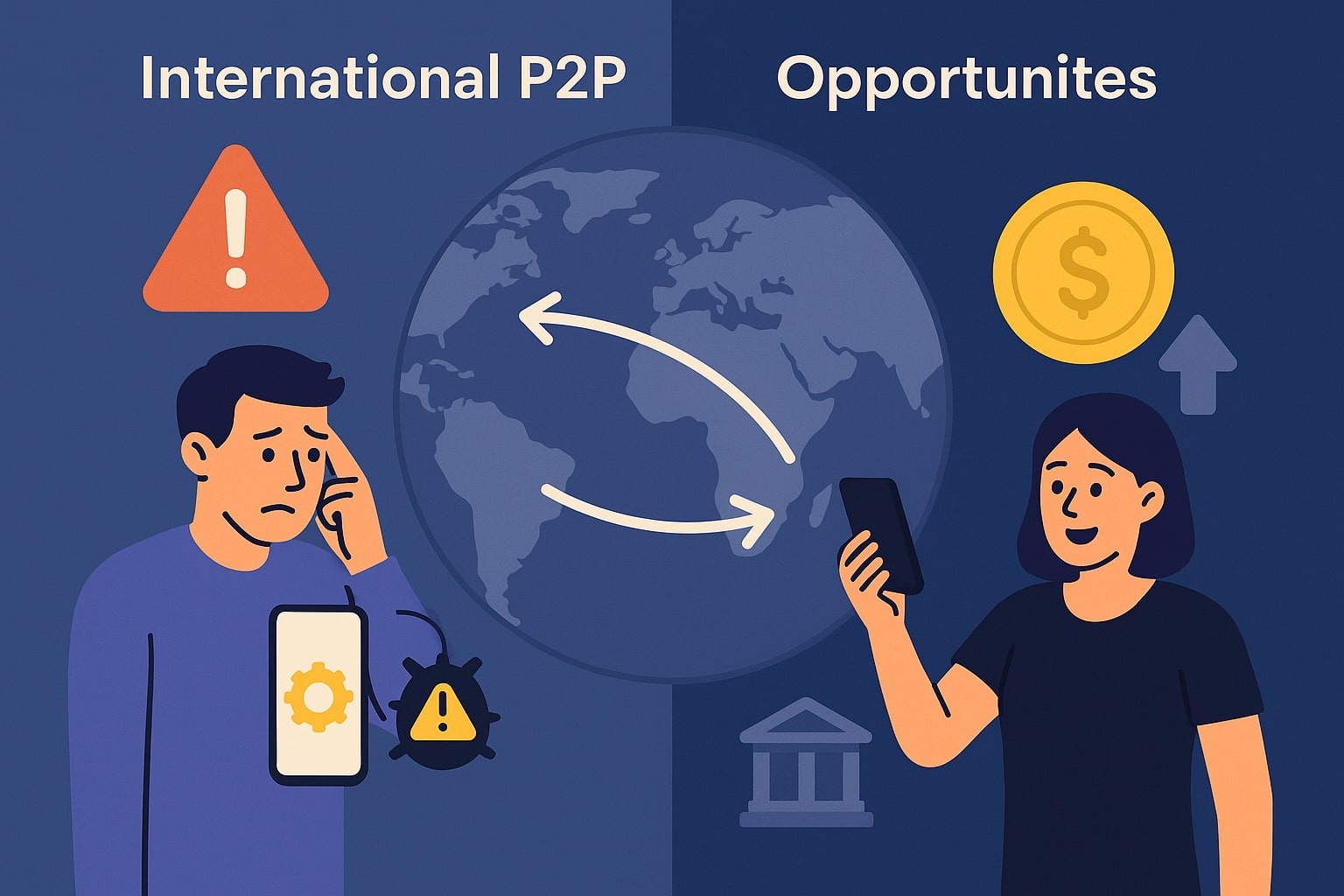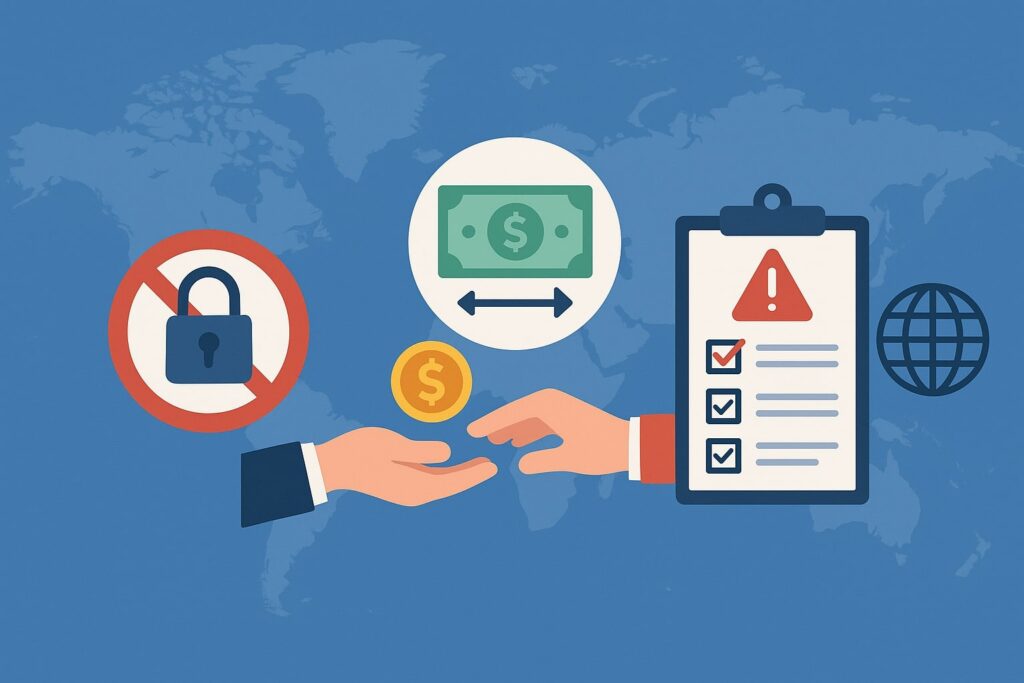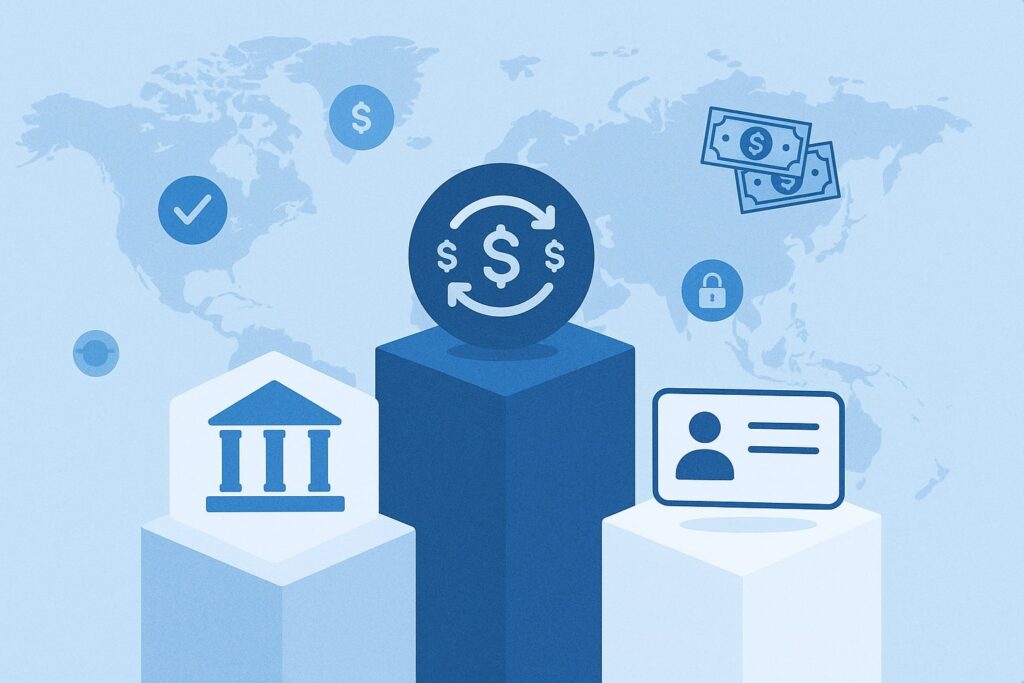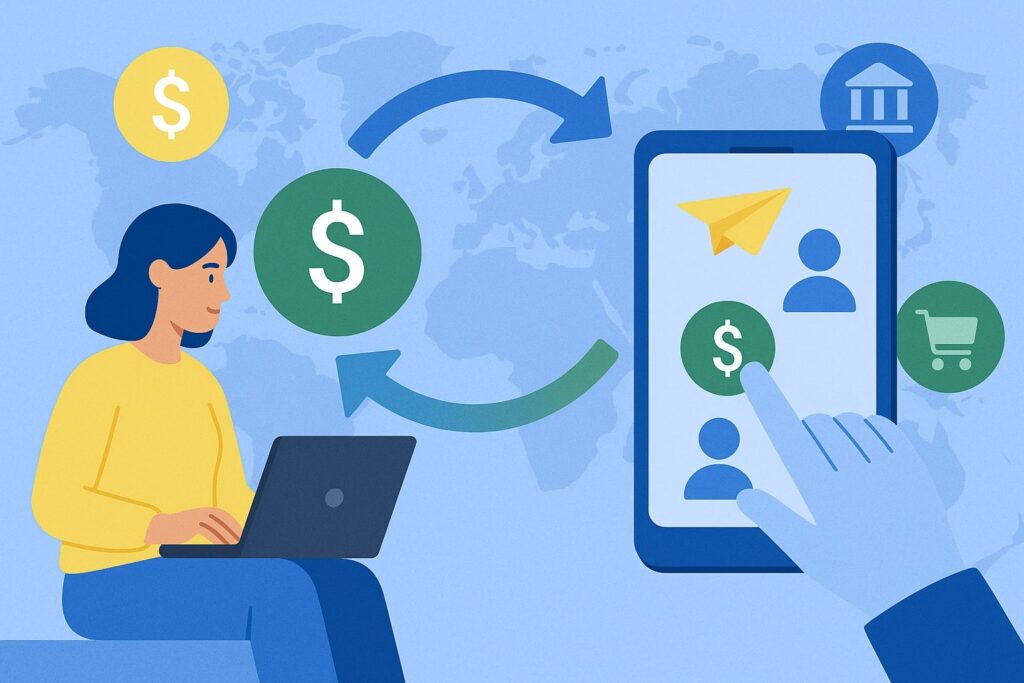
By p2pbusinesspayments October 24, 2025
International P2P payments—person-to-person transfers that cross national borders—let individuals send money directly to friends, family, freelancers, students, travelers, and micro-merchants abroad.
In the U.S. context, international P2P payments grew from niche remittances to a mainstream personal finance habit thanks to mobile apps, instant notifications, and transparent pricing.
For Americans who support relatives overseas, pay global gig workers, or split costs while traveling, international P2P payments offer speed, convenience, and control. Yet the cross-border layer creates complexity: currencies shift, local rails differ, and regulations vary by country.
International P2P payments are not just about moving funds; they’re about trust, compliance, and a consistent experience across borders. U.S. senders expect app-level ease and real-time status, while overseas recipients rely on local wallets, bank accounts, or cash-out agents.
Behind the scenes, foreign exchange (FX), correspondent banks, non-bank money transmitters, card networks, and domestic instant rails all orchestrate settlement. The result is a consumer-facing flow that feels simple while the infrastructure remains sophisticated and risk-sensitive.
For U.S. consumers and small businesses that behave like consumers (solo contractors, resellers, creators), the upside of international P2P payments includes faster delivery, lower costs than traditional remittance corridors, and better transparency.
The downside centers on unpredictable FX spreads, compliance checks that can delay transfers, and uneven recipient experiences in markets with limited financial inclusion. Understanding both sides helps you choose smarter routes, avoid fees, and stay compliant while sending money abroad confidently.
The Core Building Blocks of Cross-Border Transfers

International P2P payments ride on a blend of card schemes, bank networks, money transfer operators (MTOs), and modern payout APIs. Each component adds value and trade-offs. Card rails can offer near-instant push-to-card payouts but depend on where recipients bank.
Bank wires are robust but slower and typically costlier. MTOs streamline onboarding and compliance but may charge higher fees, especially for exotic corridors. Newer API-driven providers aggregate multiple routes, automatically picking the “best path” based on delivery time, cost, and coverage in the recipient’s market.
KYC (Know Your Customer) and AML (Anti-Money Laundering) sit at the center of cross-border orchestration. Providers verify identities, monitor transactions, and flag suspicious activity.
For U.S. users, that means occasional requests for extra documents, especially at higher limits or into high-risk countries. Sanctions screening also applies, requiring checks against lists maintained by U.S. authorities and international bodies. The result is safer international P2P payments and fewer compliance surprises later.
Finally, FX management shapes total cost. Some apps display guaranteed exchange rates for a short window; others show mid-market rates plus a markup. If you send regularly, you should compare all-in costs (transfer fees + FX spread).
In volatile periods, locked-in quotes protect recipients from last-minute shortfalls. In stable periods, low-spread options can cut total costs noticeably.
Key Challenges in International P2P Payments

International P2P payments promise “instant and affordable,” but four structural challenges remain: compliance, FX, delivery options, and user experience. Each one affects cost, speed, and trust, and each one is solvable with the right approach.
Regulatory and Compliance Friction
For U.S. residents, money transmission is regulated at the federal and state levels. Providers must hold licenses, implement BSA/AML programs, and maintain strong consumer protections. When money crosses borders, additional rules and foreign regulators enter the picture.
That can trigger identity verification at send and receive, trigger holds for enhanced due diligence, and require source-of-funds documentation. For users, this looks like extra steps or occasional delays, but it’s essential for safe, lawful transfers.
To reduce friction, pick providers that clearly publish their compliance standards and turnaround times. Complete your profile, verify your identity proactively, and keep documents handy (government ID, proof of address, and sometimes proof of income).
If you’re sending for business purposes—even small-scale freelance payments—clarify the use case during onboarding. Clear, consistent information helps systems classify your transfers accurately and reduces manual reviews, making your international P2P payments smoother and more predictable.
FX Costs and Rate Transparency
FX spreads differ widely across apps and routes. Two providers can quote the “same” exchange rate yet produce different received amounts due to hidden markups or foreign intermediary fees.
Rate guarantees add certainty but can bake in a higher buffer, while floating quotes may be cheaper but carry last-minute risk. For U.S. senders, the most reliable comparison is the recipient’s net amount after all fees, not just the headline rate.
Best practice: compare multiple services for your specific corridor (e.g., USD→MXN) and amount. Small transfers may favor fee-free but higher-spread routes; larger transfers benefit from lower spreads even with fixed fees.
If you send regularly, track rate history and consider sending when the exchange rate favors your recipient. Many platforms allow you to schedule, split, or cap transfers to manage FX risk more intelligently.
Delivery, Coverage, and Cash-Out Options
An international P2P payment is only as good as its last mile. While many recipients prefer direct bank deposit or mobile wallet credit, others need cash pickup due to local banking access or personal preference.
Delivery speed changes by method: some wallets credit instantly; bank rails can be same-day or next-day; cash agents follow local hours. Corridors with limited infrastructure may require additional intermediaries, raising costs or adding steps.
Before sending, confirm how your recipient wants to receive funds—wallet, bank, card, or cash—and whether they need specific IDs or codes to pick up money. If you’re paying a freelancer, ask which method posts fastest in their market.
For family support, align on reliability and convenience, even if it costs a dollar more. Consistent delivery builds trust and reduces follow-up messages, making your international P2P payments feel truly “instant.”
Fraud, Scams, and Account Takeover
Fraudsters target cross-border transfers because recovery can be harder once funds leave the U.S. Common schemes include fake emergencies (“I lost my passport”), marketplace overpayments, romance scams, and “friendly fraud” where a sender authorizes the payment but later disputes it.
Account takeover occurs when attackers use credential stuffing or phishing to access your app and push funds abroad quickly.
Protect yourself with strong passwords, passkeys, and multi-factor authentication (MFA). Lock down your email, because password resets often route there. Enable device approval prompts and push alerts for every international P2P payment.
If you’re uncertain about a request, verify through a known channel (phone/video) before sending. Finally, understand your provider’s dispute window and reimbursement policies—cross-border consumer protections can vary by method, app, and jurisdiction.
Opportunities: Where International P2P Payments Create Real Value

Despite challenges, the upside is significant. International P2P payments open new ways to support family, hire talent, and participate in the global digital economy from the U.S., efficiently and transparently.
Remittances with Real-Time Visibility
Remittances are the most common international P2P use case. What’s new is instant status and receipt confirmation. Many apps now show step-by-step tracking—initiated, in transit, at partner, delivered—so both sender and recipient know what’s happening.
This visibility reduces anxiety, prevents duplicate sends, and builds trust for recurring support. For families that depend on timing, plan transfers around rent dates or tuition deadlines, and use notifications to confirm delivery.
For consistent monthly remittances, consider subscription-style transfers or scheduled payments. Some providers offer loyalty pricing for repeat senders, minimizing FX spread. Others enable fee-free tiers after a certain volume.
Over time, choosing a provider that aligns with your corridor and timing can save hundreds of dollars while making your international P2P payments predictable and stress-free.
Paying Global Freelancers and Micro-Merchants
The U.S. creator economy relies on talent worldwide—designers, editors, developers, and virtual assistants. International P2P payments let you pay a person, not a company, with fewer steps than traditional cross-border B2B.
For compliance, treat these as legitimate services: document invoices, capture names and addresses, and keep receipts. Recipients may prefer local wallets that credit instantly and convert at competitive FX.
If you pay freelancers regularly, test small amounts to confirm routing and speed, then standardize on the best path. Some platforms offer “request to pay” links, QR codes, and payout to card.
For U.S. tax season, keep a clean record of transactions and categorize them in your bookkeeping tool. This turns ad hoc international P2P payments into a repeatable process with audit-ready documentation.
Travel, Study Abroad, and Emergency Support
For U.S. families with kids studying overseas, international P2P payments act as a safety valve. Unexpected expenses—medical, housing deposits, device repairs—can be covered quickly with wallet or card payouts.
Set up trusted recipients in advance, verify identity details, and perform a $1 test send before a trip. If you anticipate emergencies, keep a small balance in a multi-currency wallet and add funding sources (bank, card) ahead of time to accelerate top-ups.
Travelers can also split bills with international friends without carrying cash. If you’ll be abroad for an extended period, research whether your preferred U.S. app supports in-country top-ups or only U.S.-sourced funds.
Understanding these nuances helps you avoid declines, unnecessary FX, and delays when you need money most.
How the Money Actually Moves: Rails, Models, and Settlement
International P2P payments typically follow one of four routes: card-to-card push, wallet-to-wallet, bank-to-bank via correspondent networks, or hybrid models that convert between them. Push-to-card leverages network tokens and can be near real-time where supported.
Wallet-to-wallet delivers speed when both parties use the same provider or a connected local partner. Bank-to-bank remains common for higher values but may be slower due to intermediary banks and time zone cutoffs. Hybrid providers orchestrate multiple paths, dynamically selecting based on corridor conditions.
Settlement can be prefunded (the provider holds balances in target currencies) or post-funded (the provider executes FX at send). Prefunding accelerates delivery but requires capital and treasury expertise.
Post-funded flows can be cheaper in stable markets but risk slippage when FX volatility spikes. Advanced platforms hedge exposure, net flows across corridors, and use local clearing to minimize lifts.
For consumers, the takeaway is simple: your choice of provider determines not only fees but also which rails are used—and that determines speed and reliability.
Security, Privacy, and Consumer Protections for U.S. Senders
Security in international P2P payments combines technical controls and policy protections. On the technical side, look for device binding, biometric login, encryption at rest and in transit, fraud scoring, and anomaly detection.
On the policy side, reputable providers publish clear dispute processes, transparent refund policies, and dedicated support for cross-border issues. U.S. consumers should review limits (daily, monthly, per-transaction), hold on new recipients, and rules for reversing mistaken sends.
Privacy is equally important. Cross-border transfers can involve multiple processors and partners. Choose providers with strong privacy statements, data minimization practices, and limited data sharing.
If you must share sensitive documents for enhanced due diligence, confirm secure upload channels in app, not email. Good security hygiene—unique passwords, MFA, passkeys, and alerting—makes your international P2P payments resilient against account takeover and social engineering attempts.
Fees and FX: Calculating the True Cost
The real cost of international P2P payments equals transfer fee + FX spread + any third-party or recipient fees. Some providers advertise “$0 fee” but recoup costs in the exchange rate. Others charge a small fixed fee but offer a tighter spread, which can be cheaper for large amounts.
Additionally, certain destinations charge local cash-out or wallet-to-bank fees. Always evaluate the recipient’s net amount and the guaranteed delivery time.
For U.S. senders, a practical strategy is to benchmark three providers for your corridor. Send the same amount, compare quoted delivery times and the recipient’s expected amount, and track actual delivery. Over a few transfers, a consistent winner usually emerges.
If your amounts vary, pay attention to fee tiers: some services become much cheaper above certain thresholds. When rates are volatile, using a provider that lets you lock the FX for a short window can protect your recipient’s purchasing power.
Product Design: What “Good” Looks Like in an International P2P App
A best-in-class international P2P payments experience is predictable, transparent, and forgiving. Predictable means clear timelines (“Instant, 30 minutes, Same Day”), stable limits, and upfront documentation requirements.
Transparent means plain-English pricing, real-time FX quotes, and a receipt that itemizes fees. Forgiving means easy error correction, cancelation if the payment hasn’t been claimed, and live support for cross-border issues.
For power users, additional features add value: reusable recipient profiles, multi-currency balances, scheduled sends, rate alerts, and exportable statements for taxes and bookkeeping. If you frequently pay freelancers, look for invoice uploads, memo fields, or payment links.
If you primarily send family remittances, prioritize cash-out coverage and weekend delivery. The right feature mix converts international P2P payments from a one-off task into a smooth, repeatable habit.
Risk Management for Everyday Senders
You don’t need to be a compliance expert to manage risk. A few habits keep your international P2P payments safe. First, confirm the recipient name, wallet handle, or card details out-of-band using a known phone number or video chat.
Second, avoid sending to new recipients immediately after password changes or device resets, when fraud risk is higher. Third, watch for mismatched details (country, currency, or name spelling) and pause if anything looks off.
Set personal limits and alerts in your app. Treat unusual requests—urgent, emotional, or secretive—as red flags. If you help relatives abroad, agree on code words and standard phrases before emergencies arise.
Finally, if a payment goes wrong, contact support immediately and document everything. Quick action increases the odds of recovery, especially if the funds haven’t yet been claimed or settled to the recipient.
Compliance Basics for U.S. Users: What to Expect
When you sign up with a U.S.-based provider, expect identity verification. You may be asked for full name, date of birth, SSN (or last four digits), and a government-issued ID. Large or unusual transfers can trigger additional checks, including proof of address or source of funds.
This is normal and helps keep international P2P payments available and trusted. Refusing to provide documents may result in lower limits or account restrictions.
Certain countries and counterparties may be restricted by sanctions or local regulations. Reputable providers block these routes proactively, so a “not supported” message often reflects legal obligations rather than app limitations.
If your corridor is permitted but considered higher risk, anticipate longer review times. Planning ahead—especially for time-sensitive tuition, rent, or medical bills—helps avoid last-minute stress.
How to Choose a Provider: A U.S. Buyer’s Checklist
Picking the right platform for international P2P payments comes down to corridor coverage, cost, speed, and support. Use this checklist before you commit:
- Corridor Fit: Does the provider support your destination country, currency, and preferred delivery (wallet, bank, card, cash)?
- Total Cost: What is the all-in cost for your typical amount, including FX? Is the FX rate guaranteed?
- Speed and Reliability: Are most transfers instant or same-day? What happens on weekends and holidays?
- Limits and Holds: Are your amounts within daily or monthly limits? Will first-time recipients face holds?
- Security: Is MFA required? Are there device approvals, alerts, and biometrics?
- Support: Is live chat or phone support available for cross-border issues?
- Receipts and Records: Can you export statements for taxes or bookkeeping?
- User Reviews and Corridor Specifics: Look for feedback specific to your USD→target currency route.
By comparing these criteria across two or three providers, most U.S. senders can optimize cost without sacrificing delivery confidence.
Practical Playbooks for Common U.S. Use Cases
International P2P payments cover diverse needs. These quick playbooks help you act with clarity.
Family Remittances
- Pre-verify recipient identity and preferred cash-out method.
- Schedule monthly sends near rent or school fee due dates.
- Use providers with instant receipts and delivery status.
- Keep backup routes for holidays and outages.
- Track net amounts over time to choose the most cost-effective corridor.
Paying Freelancers
- Collect full legal name, email, and country upfront.
- Start with a small test transfer to validate speed and routing.
- Keep invoices and categorize payments for U.S. taxes.
- Standardize on the fastest, most reliable method your freelancer prefers.
- Consider multi-currency wallets if you pay multiple countries regularly.
Travel and Study Abroad
- Add recipients and funding sources before you fly.
- Do a $1 test send to validate the route and cash-out.
- Keep MFA and device approvals enabled even while traveling.
- Understand roaming SMS issues; use authenticator apps or passkeys.
- Maintain a small multi-currency balance for emergencies.
Future Trends: Where International P2P Payments Are Headed
Cross-border consumer payments are moving toward instant, 24/7 availability with transparent FX and richer data. Expect broader interoperability between wallets, more direct connections to domestic instant rails, and smarter routing that chooses the fastest, cheapest, and most reliable path automatically.
Tokenized credentials and passkeys will reduce account takeover. More corridors will support real-time payouts to bank accounts or cards, making international P2P payments feel “local” on both ends.
We’ll also see richer compliance automation—screening that understands context, reduces false positives, and clears legitimate transactions faster. On the consumer side, unified super-apps will blend remittances, bill pay, savings, and credit.
For U.S. senders, that means fewer apps, better rates, and more consistent experiences across countries. The long-term destination is simple: instant, affordable, and secure cross-border money movement that works just like domestic P2P.
Step-by-Step: Sending Your First International P2P Payment from the U.S.
- Pick a corridor and method. Decide the destination country, currency, and delivery type (wallet, bank, card, cash).
- Choose two providers to compare. Create accounts, complete KYC, and enable MFA.
- Quote your amount. Compare fees and FX. Note the recipient’s expected net amount and delivery time.
- Add the recipient. Enter the exact name, handle, wallet ID, IBAN, or card details. Double-check spelling.
- Test with a small amount. Confirm routing, speed, and notifications.
- Send the full amount. Save the receipt and share the delivery confirmation.
- Review and optimize. Track costs and timing over two or three transfers; standardize on the best route.
By following this checklist, your first international P2P payments will be smooth, safe, and cost-effective.
FAQs
Q.1: Are international P2P payments legal for personal and freelance use?
Answer: Yes. Using licensed providers to send money to friends, family, or freelancers is lawful, provided you follow KYC and AML requirements. Some countries or recipients may be restricted by sanctions or local rules.
If a provider blocks your corridor, it is usually complying with legal obligations. Keep documentation—IDs, invoices, and receipts—especially for freelance payments. That makes your international P2P payments traceable, auditable, and aligned with U.S. expectations.
Q.2: Why do fees and FX rates differ across apps for the same corridor?
Answer: Providers use different rails, partners, and hedging strategies. One app might offer a low fixed fee but a higher FX spread; another may advertise “no fee” while embedding costs in the rate. Always compare the recipient’s net amount and the promised delivery window.
Over time, a consistent provider for your corridor will minimize the total cost of your international P2P payments without risking speed or reliability.
Q.3: How fast are cross-border P2P transfers?
Answer: Speed depends on corridor, method, compliance checks, and time of day. Wallet-to-wallet and push-to-card can be near-instant; bank deposits can be same-day or next-day.
First-time recipients often add a short delay due to verification. Plan ahead for rent, tuition, or medical deadlines. With good preparation, most international P2P payments from the U.S. can arrive within minutes to hours.
Q.4: What security steps should I take before sending?
Answer: Enable MFA or passkeys, use unique passwords, and lock down your email. Verify recipient details over a trusted channel. Avoid urgent, secretive requests. Keep alerts on for every send and change.
If something goes wrong, contact support immediately. These habits make international P2P payments safer and help providers recover funds if a transfer hasn’t been claimed.
Q.5: Can I reverse an international P2P payment?
Answer: It depends on the provider and status. If a payment is pending or unclaimed, you may be able to cancel it. Once funds are delivered or cashed out, reversal is difficult. Start recovery attempts as soon as you suspect an issue.
Well-designed providers show live status, which helps you act quickly. Treat international P2P payments as final and double-check details before you hit send.
Q.6: Do I have to pay U.S. taxes on personal transfers?
Answer: Personal gifts are generally not taxable to the recipient, but U.S. gift tax rules and reporting thresholds may apply for large amounts. Payments to freelancers are different—those can be business expenses for you and income for them.
Keep thorough records. While this is general information, consult a qualified tax professional for advice specific to your situation.
Q.7: What documents might a provider request?
Answer: Expect a government ID, sometimes proof of address, and for larger or atypical transfers, source-of-funds (pay stub or bank statement).
These requests help providers meet AML requirements and keep international P2P payments available to legitimate users. Upload documents through secure in-app channels and avoid email attachments.
Q.8: Is it safer to send to a wallet, bank account, or card?
Answer: Each method has trade-offs. Wallets can be fast and user-friendly, but recipients must maintain access. Bank deposits are familiar and stable, though sometimes slower.
Push-to-card can be near-instant if supported by the recipient’s issuer. Choose the option your recipient can manage easily and securely. Reliability often matters more than minor cost differences.
Conclusion
International P2P payments empower U.S. senders to support family, hire global talent, and participate in a borderless economy with confidence. The formula for success is clear: pick a corridor-friendly provider, verify identity early, compare all-in costs, and standardize the method your recipient prefers.
Protect your accounts with MFA and passkeys, avoid pressure-based scams, and keep clean records for taxes and support requests.
As rails grow more interoperable and FX gets more transparent, international P2P payments will feel more like domestic transfers—instant, predictable, and fairly priced. Until then, informed choices make all the difference.
With the strategies in this guide, you’ll reduce fees, cut delays, and deliver funds where they matter most, turning international P2P payments into a reliable, everyday financial tool for the U.S. sender and the global recipient.